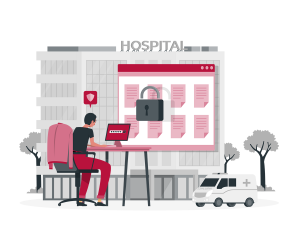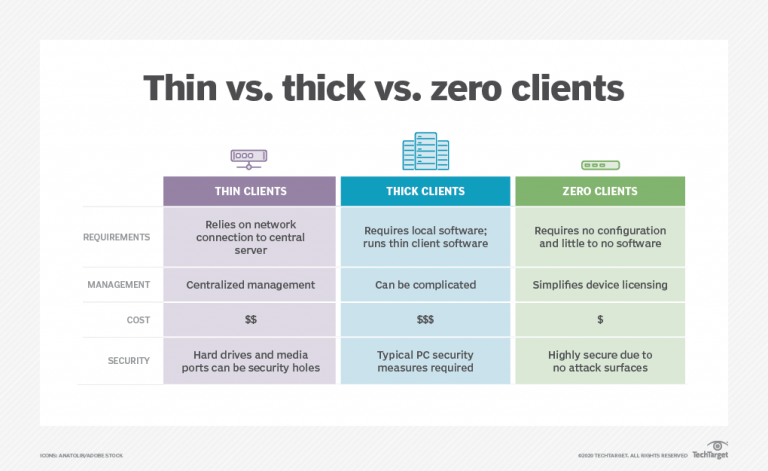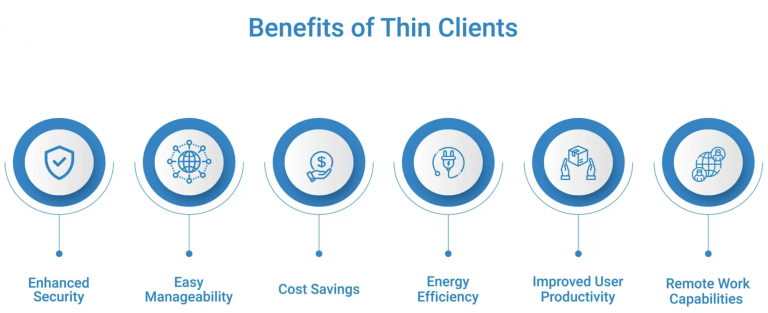
In an increasingly connected world, healthcare organizations are under immense pressure to maintain stringent security standards while managing sensitive patient data. As cyber threats continue to evolve, there is an urgent need to adopt robust and efficient approaches to safeguarding healthcare applications. Thin clients is a powerful technology solution that can solve these challenges and significantly enhance security and reliability in healthcare environments.
In this article, we at Itirra, a leading Seattle-based healthcare software development company, will explore the benefits of employing thin clients for better healthcare application security. We recognize the importance of protecting patient information and maintaining compliance with industry regulations. Healthcare organizations can minimize the risks associated with data breaches by harnessing the power of thin clients while optimizing system performance and reducing IT management overhead.
Throughout the article, we will discuss the fundamental principles of thin clients, outline their advantages in the context of healthcare application security, and delve into best practices for deploying thin clients in healthcare settings. We aim to provide healthcare organizations with the knowledge and tools necessary to leverage the potential of thin clients, thus creating a secure and efficient environment for managing critical patient data. By embracing thin client technology, healthcare providers can effectively safeguard their applications and maintain the highest levels of patient trust and confidence.
What is a thin client?
A thin client is a lightweight computing device that relies on centralized servers for processing, data storage, and application execution rather than housing these resources locally. Designed with minimal hardware components, thin clients connect to remote servers through secure protocols, transmitting only display information, keyboard inputs, and mouse movements. Thin clients prioritize simplicity, centralization, and robust security.
This compelling approach to computing offers numerous advantages, including enhanced security, simplified management, reduced power consumption, and scalability, making thin clients an attractive option for healthcare organizations seeking streamlined and secure solutions. Let’s explore the fundamental principles of thin clients and how they differ from traditional computing systems.
Centralized computing
The core principle of thin clients is their reliance on centralized computing resources. Unlike traditional desktops or laptops, thin clients do not have powerful processors, extensive memory, or large storage capacities. Instead, they connect to powerful servers where applications, processing, and data storage take place. This centralized approach significantly reduces the attack surface at the client level, making it harder for malicious actors to compromise the system.
Minimal hardware
Thin clients are purpose-built devices with minimal hardware components. They typically include a basic processor, a small amount of memory (RAM), and just enough storage for the operating system and essential software. This stripped-down design not only reduces the physical footprint and power consumption of the device but also minimizes potential vulnerabilities that attackers could exploit.
Remote access
Thin clients rely on remote access protocols, such as Remote Desktop Protocol (RDP) or Virtual Network Computing (VNC), to connect to the centralized server. Users interact with the server through these protocols, which provide a seamless and secure connection while transmitting only the necessary display information, keyboard inputs, and mouse movements. This approach ensures that sensitive data never leaves the secure confines of the centralized server, thereby reducing the risk of data breaches or unauthorized access.
Streamlined management
In a thin client environment, IT administrators can centrally manage and maintain the entire infrastructure, including applications, operating systems, and security policies. This centralized management model simplifies updates, patching, and security enforcement, as changes can be made on the server level and automatically propagated to all connected thin clients. Consequently, this reduces the administrative burden and potential for human error, resulting in a more secure and efficient system.
Scalability and flexibility
Thin clients offer a highly scalable and flexible computing solution, as new devices can be easily added or removed from the network without affecting the overall performance of the centralized server. This adaptability is particularly beneficial for healthcare organizations, which often need to accommodate fluctuating user demands, seasonal workloads, or rapidly expanding infrastructures.
The fundamentals of thin clients revolve around centralized computing, minimal hardware, remote access, streamlined management, and scalability. These principles contribute to a more secure and efficient computing environment, making thin clients ideal for enhancing healthcare application security.

How can thin clients improve healthcare application security?
The unique characteristics of thin clients offer several advantages for healthcare application security. In this high-stakes industry, where protecting sensitive patient data is paramount, thin clients can be crucial in bolstering security and maintaining regulatory compliance. Below, we discuss the key benefits of using thin clients in healthcare settings:
Enhanced security
Thin clients significantly reduce the attack surface by centralizing data storage and processing on secure servers. This minimizes the risk of unauthorized access or data breaches, as sensitive information never leaves the server environment. Moreover, the simplified hardware and software configuration of thin clients makes them less vulnerable to malware and other cyber threats.
Streamlined management
Centralized management of thin client infrastructures enables IT administrators to implement security policies, updates, and patches efficiently. This ensures that all devices remain up-to-date and in compliance with industry regulations, such as HIPAA. By reducing the potential for human error and eliminating the need to manage individual endpoints, healthcare organizations can maintain a more secure environment.
EHR integration
SMART on FHIR apps can be easily embedded within EHR systems, allowing healthcare providers to access these tools and features directly from their EHR workflows. This integration simplifies the user experience and promotes more efficient use of healthcare data.
Reduced data leakage
With thin clients, data is never stored or processed on local devices. This significantly decreases the risk of data leakage in cases of device theft or loss, a common concern in healthcare facilities. Healthcare organizations can effectively safeguard against unauthorized access and data breaches by keeping sensitive patient data securely stored on centralized servers.
Role-based access control
Thin clients can be easily configured to provide role-based access control, ensuring that users can only access the specific applications and data necessary for their job responsibilities. This granular access control mechanism helps prevent unauthorized access to sensitive information, further enhancing the security of healthcare applications.
Rapid incident response
In the event of a security breach or cyber attack, thin client infrastructures enable faster incident response and recovery. Administrators can quickly isolate affected devices, remediate vulnerabilities, and restore secure access to applications and data. This rapid response capability is crucial for minimizing potential damage and maintaining the integrity of healthcare systems.
Lower TCO and efficiency
While not directly related to security, the reduced total cost of ownership (TCO) and energy efficiency of thin clients can free up resources for investment in advanced security measures. The lower hardware, maintenance, and energy costs associated with thin clients enable healthcare organizations to allocate more funds toward cybersecurity initiatives and infrastructure upgrades.
The adoption of thin clients in healthcare settings offers significant advantages in terms of application security, data protection, and regulatory compliance. By leveraging the inherent benefits of thin client technology, healthcare organizations can create a more secure and efficient environment for managing sensitive patient data and delivering high-quality care.

Best practices for deploying thin clients in healthcare settings
Deploying thin clients in healthcare settings requires careful planning and implementation to ensure optimal security and performance. By adhering to the following best practices, healthcare organizations can successfully deploy thin clients in their settings, maximizing the security, efficiency, and cost-saving benefits of this technology. With a well-planned and carefully executed deployment, thin clients can become valuable assets in enhancing healthcare application security and overall operational performance.
Assess infrastructure requirements
Begin by thoroughly assessing your organization’s existing infrastructure, including network bandwidth, server capacity, and storage needs. Determine the resources required to support the centralized processing and data storage demands of a thin client environment. This assessment will help you identify any necessary upgrades or improvements before deploying thin clients.
Select appropriate thin client devices
Choose thin client devices that best meet the specific requirements of your healthcare setting. Consider factors such as compatibility with remote access protocols, built-in security features, and the level of customization offered by the manufacturer. Additionally, evaluate the device’s performance, energy efficiency, and ease of management.
Implement a robust server infrastructure
Invest in a secure and high-performance server infrastructure to support the centralized processing and storage needs of your thin client environment. Utilize technologies such as server virtualization, high-availability configurations, and regular backups to ensure the reliability and resilience of your server infrastructure.
Configure role-based access control
Implement granular, role-based access control policies to restrict users’ access to sensitive data and applications. Assign user roles based on job responsibilities, limiting access to the minimum necessary for each role. This approach helps minimize the risk of unauthorized access and enhances overall application security.
Establish secure connectivity
Ensure that thin clients connect to the centralized server using secure remote access protocols, such as Remote Desktop Protocol (RDP) with encryption or Virtual Private Network (VPN) connections. These protocols help maintain the confidentiality and integrity of data transmitted between the thin client devices and the server.
Plan for scalability
Design your thin client deployment with scalability in mind, allowing for the seamless addition or removal of devices as needed. This will enable your organization to accommodate fluctuations in user demands and support future growth without compromising security or performance.
Continuously monitor and update
Regularly monitor the performance and security of your thin client infrastructure, including the server environment and connected devices. Implement a proactive approach to updates, patching, and security policy enforcement to ensure that all components remain up-to-date and in compliance with industry regulations.
Conclusion
Thin clients offer a compelling solution for healthcare organizations seeking to enhance application security and protect sensitive patient data. With their centralized computing model, minimal hardware, and secure remote access capabilities, thin clients can significantly reduce the attack surface and minimize the risk of data breaches. By embracing this technology, healthcare providers can strengthen their security posture while benefiting from streamlined management, increased scalability, and lower total cost of ownership.
As we have explored in this article, understanding the fundamentals of thin clients, appreciating their advantages in the context of healthcare application security, and adopting best practices for deployment can empower healthcare organizations to leverage this innovative technology successfully. A well-executed thin client deployment can help create a more secure and efficient environment for managing critical patient data and delivering high-quality care.
At Itirra, a leading Seattle-based healthcare software development company, we are dedicated to helping organizations navigate the complexities of modern healthcare technology, including thin client solutions. By providing expert guidance, industry insights, and tailored solutions, we support our clients in their pursuit of improved security, operational excellence, and patient satisfaction. We believe that thin client technology has the potential to play a pivotal role in shaping the future of healthcare application security, and we are committed to helping our clients harness the full potential of this transformative approach.

